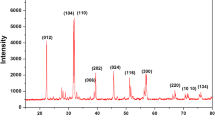Abstract
The motion of the ion pairs under the applied electric field is an important phenomenon in the storage properties of the capacitive devices. In this study, two different molecules, 1,3,6,8-pyrenetetrasulfonic acid tetrasodium salt hydrate (P4) and tetra-alkyl ammonium bromide (TAAB), were used as ionic groups in the PVA gel electrolytes. The counter ions of P4 and TAAB are Na+ and Br – and their masses (about 23 and 80 g/mole) are much smaller than the masses of their host molecules \({\mathrm{P}}_{4}^{-4}\) and TAAB+1 (about 524 and 322 g/mole). Three different PVA gel electrolytes in slab configurations were synthesized and characterized: PVA gel electrolyte including only P4, only TAAB, and mixture of these ionic groups. The binary system was obtained by putting the gel electrolyte including TAAB on the gel electrolyte including P4. cyclic voltammetry (CV), and galvanostatic charge discharge (GCD) techniques were used to characterize the electrolytes. The results of the proposed binary gel polymer electrolyte were compared with single and mixture electrolytes. It was observed that since P4 and TAAB host molecules are highly massive, they can shield some part of the counter ions when an electric field was applied. In addition, the agglomeration of the TAAB molecules in the PVA matrix causes trapping the counter ions in the dense regions and prevents the motion of the counter ions under the applied field and then induces the increasing internal resistance. Therefore, the effective mass of TAAB molecules increases considerably, and when an electric field is applied, they move slowly.











Similar content being viewed by others
References
Shinde PA et al (2023) Realizing superior redox kinetics of metal-metal carbides/carbon coordination supported heterointerface for stable solid-state hybrid supercapacitor. Chem Eng J 454:140246
Shinde PA et al (2021) All-redox solid-state supercapacitor with cobalt manganese oxide@ bimetallic hydroxides and vanadium nitride@ nitrogen-doped carbon electrodes. Chem Eng J 405:127029
Shinde PA et al (2016) Enhanced electrochemical performance of monoclinic WO3 thin film with redox additive aqueous electrolyte. J Coll Inter Sci 483:261–267
Chodankar NR et al (2022) High energy superstable hybrid capacitor with a self‐regulated Zn/electrolyte interface and 3D graphene‐like carbon cathode. InfoMat 4.10:e12344
Vangari M, Pryor T, Jiang Li (2013) Supercapacitors: review of materials and fabrication methods. J Energy Eng 139(2):72–79
Mustafa GM, Ali G (2022) Energy storage systems. Handbook of Energy Transitions. CRC Press 195–213
Ye W et al (2021) New types of hybrid electrolytes for supercapacitors. J Energy Chem 57:219–232
Pal B et al (2019) Electrolyte selection for supercapacitive devices: a critical review. Nanos Adv 1.10:3807–3835
Das HT et al (2022) Polymer composites with quantum dots as potential electrode materials for supercapacitors application: a review. Polymers 14.5:1053
Bhat TS, Patil PS, Rakhi RB (2022) Recent trends in electrolytes for supercapacitors. Journal of Energy Storage 50:104222
Tao L et al (2019) Highly improved photocurrent and stability of dye-sensitized solar cell through quasi-solid-state electrolyte formed by two low molecular mass organogelators. Organ Electron 65:179–184
Guan X et al (2019) In situ growth of a high-performance all-solid-state electrode for flexible supercapacitors based on a PANI/CNT/EVA composite. Polymers 11.1:178
Li M et al (2022) Recent progress of the active materials with various micro-structures for flexible textile-based supercapacitors. Adv Fiber Mater 1–22
Yong S, Owen J, Beeby S (2018) Solid-state supercapacitor fabricated in a single woven textile layer for e-textiles applications. Adv Eng Mater 20(5):1700860
Fan H et al (2022) Counterion mobility in ion-exchange membranes: spatial effect and valency-dependent electrostatic interaction. ACS ES&T Engineering
Ge X et al (2022) Current challenges and perspectives of polymer electrolyte membranes. Macromolecules
Angarita-Gomez S, Balbuena PB (2022) Ion motion and charge transfer through a solid-electrolyte interphase: an atomistic view. J Solid State Electrochem 1–9
Vargas-Barbosa NM, Roling B (2020) Dynamic ion correlations in solid and liquid electrolytes: how do they affect charge and mass transport? ChemElectroChem 7(2):367–385
Kashyap HK et al (2011) How is charge transport different in ionic liquids and electrolyte solutions?. J Phys Chem B 115.45:13212–13221
Braun S, Yada C, Latz A (2015) Thermodynamically consistent model for space-charge-layer formation in a solid electrolyte. J Phys Chem C 119(39):22281–22288
Zhong J et al (2015) Improved energy density of quasi-solid-state supercapacitors using sandwich-type redox-active gel polymer electrolytes. Electrochimica Acta 166:150–156
Fan LQ et al (2016) Improving the energy density of quasi-solid-state supercapacitors by assembling two redox-active gel electrolytes. Int J Hydrog Energy 41.13:5725–5732
Aljafari B et al (2019) Polyvinyl alcohol-acid redox active gel electrolytes for electrical double-layer capacitor devices. J Solid State Electrochem 23.1:125–133
Biesheuvel PM, Porada S, Dykstra JE (2018) The difference between Faradaic and non-Faradaic electrode processes. arXiv preprint https://arxiv.org/abs/1809.02930
Fang Y (2022) Nanostructured carbon-based composites for improving safety and flexibility of energy storage devices. University of Cincinnati, Diss
Paul A et al (2022) High performance asymmetric supercapacitor device based on lanthanum doped nickel-tin oxide/reduced graphene oxide composite. J Energy Storage 55:105526
Zingre P, Deshmukh AD (2022) Carbon nanocomposite for energy storage applications. Novel Applications of Carbon Based Nano-materials 125
Riaz A et al (2021) Review on comparison of different energy storage technologies used in micro-energy harvesting, WSNs, low-cost microelectronic devices: challenges and recommendations. Sensors 21.15:5041
Author information
Authors and Affiliations
Corresponding author
Ethics declarations
Competing interests
The authors declare no competing interests.
Additional information
Publisher's Note
Springer Nature remains neutral with regard to jurisdictional claims in published maps and institutional affiliations.
Supplementary Information
Below is the link to the electronic supplementary material.
Rights and permissions
Springer Nature or its licensor (e.g. a society or other partner) holds exclusive rights to this article under a publishing agreement with the author(s) or other rightsholder(s); author self-archiving of the accepted manuscript version of this article is solely governed by the terms of such publishing agreement and applicable law.
About this article
Cite this article
Öztürk, T.P., Gelir, A., Keshtiban, N.A. et al. Synthesis and characterization of PVA-based binary-gel electrolytes including massive ions. J Solid State Electrochem 27, 885–894 (2023). https://doi.org/10.1007/s10008-023-05390-4
Received:
Revised:
Accepted:
Published:
Issue Date:
DOI: https://doi.org/10.1007/s10008-023-05390-4




